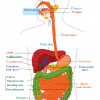Rhythm of the Night
 Circadian rhythms, or cycles of activity during a 24 hour period, are highly conserved across species. While we have much to learn about these daily patterns of life, scientists have found an organism that may offer new insight.
Circadian rhythms, or cycles of activity during a 24 hour period, are highly conserved across species. While we have much to learn about these daily patterns of life, scientists have found an organism that may offer new insight.
The timing of this internal clock is related to the amount of exposure to light. How do circadian rhythms work in organisms that are not exposed to light? A Somalian cavefish, Phreatichthys andruzzii, is a blind species that has been living without light for approximately 1.4 to 2.6 million years!
Researchers compared the cave fish to zebrafish during exposures to 12 hour period of light followed by 12 hour period of dark. The cave fish remained active at irregular times while the zebrafish were active during exposure to light. Also, it was identified that in the zebrafish, genes associated with circadian rhythms were activated from exposure to light while the same genes in the cavefish were not.
In addition to light, these rhythms can also respond to other factors, including food. When scientists fed both types of fish at specific times for a month, they found that both fish were ready to eat at those times, demonstrating the circadian rhythms. Also, the genes associated with the rhythms were activated in both fish.
Photoreceptors are cells with specialized proteins that respond to light. While the genes associated with circadian rhythms in the cave fish were normal but not activated, it was found that genes for certain photoreceptors were mutated. The mutation caused important sections of the photoreceptors to be missing. After introducing functioning genes into cave fish, it appears that these transgenic fish could only respond to blue and green light. This tells us that there are photoreceptors for light that we do not know about!
The cave fish offers scientists an opportunity to learn more about not only circadian rhythms, but also the mechanisms behind how we respond to various forms of stimuli.
| Print article | This entry was posted by Erin McKechnie on September 8, 2011 at 4:41 pm, and is filed under DNA From The Beginning. Follow any responses to this post through RSS 2.0. You can leave a response or trackback from your own site. |




